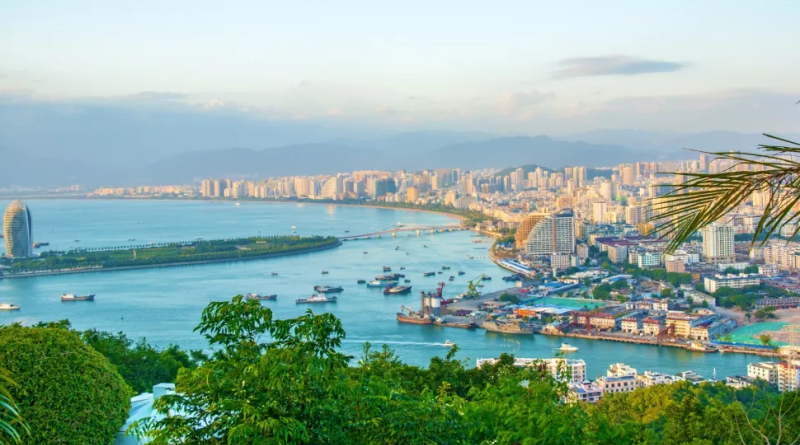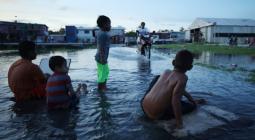What countries and cities will disappear due to rising sea levels?

And will they become submerged within our lifetime?
Sea levels are rising rapidly. The rate at which they are rising has more than doubled, from 0.06 inch (1.4 millimeters) annually throughout most of the 20th century to 0.14 inch (3.6 millimeters) per year from 2006 to 2015, according to the National Oceanic and Atmospheric Administration (NOAA).
NOAA predicts that sea levels will likely rise by at least 1 foot (0.3 m) above the levels seen in 2000 by the start of the next century, while the United Nations Intergovernmental Panel on Climate Change estimates that they will rise by 16 to 25 inches (40 and 63 centimeters) by 2100.
Should sea levels rise to this extent, it could wreak havoc around the globe. As many as 250 million people, spanning all continents, could be "directly affected" by 2100, according to a 2019 study in the journal Nature Communications.
"Whether cities or countries disappear depends on whether we as humans are doing something to counteract the threat," Gerd Masselink, a professor in coastal geomorphology at the University of Plymouth in the United Kingdom, told Live Science in an email. "Most of the Netherlands is already below sea level but is not disappearing, because the Dutch are building and maintaining their coastal defenses."
Which countries will be most affected?
First, let's look at the countries with the lowest elevations.
According to the Union of Concerned Scientists (UCS), the Maldives, made up of 1,200 small coral islands and home to around 540,000 people, is the flattest country on Earth, with an average elevation of just 3 feet (1 m). Should the Maldives experience sea level rise on the order of just 1.5 feet (45 cm), it will lose around 77% of its land area by 2100, according to the UCS.
Another country with an extremely low average elevation — around 6 feet (1.8 m) above sea level — is Kiribati. This small island in the heart of the Pacific, with a population of close to 120,000, could lose two-thirds of its land if sea levels rise by 3 feet.
The rising sea levels are a threat to Male, the Maldivian capital. Note the coastal defenses already in place. (Image credit: niromaks via Getty Images)
In fact, nearly everyone who lives on a Pacific island is likely to be severely affected by rising sea levels. Around 3 million Pacific islanders live within 6.2 miles (10 km) of the coast and, therefore, might need to relocate before the end of the century, according to the Science and Development Network, a nonprofit focused on facilitating scientific learning.
Sea level rise has already led to the disappearance of at least five "vegetated reef islands" that were previously part of the Solomon Islands, with "a further six islands experiencing severe shoreline recession," according to a 2016 study in the journal Environmental Research Letters.
These Pacific islands, though very much in jeopardy, tend to have relatively small populations. So what larger nations might be hit hardest?
The country where the most people will potentially be affected by sea level change is China, with 43 million people in precarious coastal locations. Other countries subject to face major issues related to rising sea levels include Bangladesh, where 32 million people will be at risk by 2100, and India, with 27 million, according to the European Union-funded Life Adaptate project.
So, while various countries around the world are set to see the consequences of rising sea levels firsthand by the end of the century and many millions will be affected, it seems unlikely that any countries, even those with very low elevations, will disappear entirely by 2100 — though it could be just a matter of time before some are consumed by the ocean.
Coastal cities
While no country is likely to be devoured by 2100, numerous major cities are at very serious risk of being inundated. One of the most clear-cut examples of rising sea levels causing significant, real-world difficulties is Jakarta, the capital of Indonesia.
Jakarta, home to around 10 million people, has been dubbed the "fastest-sinking city in the world" by the BBC; it is sinking by 2 to 4 inches (5 to 10 cm) each year due to "excessive groundwater drainage," according to Earth.org, a nonprofit environmental organization based in Hong Kong.
When coupled with rising sea levels, this is a recipe for disaster. According to the World Economic Forum, much of Jakarta could be underwater by 2050. In fact, Jakarta's situation is so dire that it is being replaced as Indonesia's capital by Nusantara, a soon-to-be built city on the east coast of Borneo, around 1,200 miles (2,000 km) from Jakarta.
But Jakarta is far from the only city with an uncertain future. According to the World Economic Forum, by 2100, Dhaka, Bangladesh (population 22.4 million); Lagos, Nigeria (population 15.3 million); and Bangkok, Thailand (population 9 million) could also be entirely drowned or have vast tracts of land underwater and unusable.
Rising sea levels are also likely to majorly impact the United States. Based on recent projections, many U.S. cities could face serious issues by 2050, with vast swathes of land potentially rendered unlivable.
According to NOAA, "in many locations along the U.S. coastline, high-tide flooding is now 300% to more than 900% more frequent than it was 50 years ago," which suggests that sea levels are a valid cause for concern.
New York City is most at risk, according to research from Climate Central. The report states that, by 2050, nearly half a million (426,000) New Yorkers will be living on "threatened land." New York's vulnerability to flooding was seen clearly in 2012, when the city was heavily impacted by Hurricane Sandy. At least 43 people in the city died as a result of the superstorm, around a quarter of a million vehicles were destroyed, and there was at least $32 billion worth of "damage and loss," then-Gov. Andrew Cuomo said at the time, according to Politico.
However, in terms of susceptibility to flooding, Florida seems certain to be the state that is hit hardest. According to Climate Central's research, 36 of the 50 U.S. cities that are most vulnerable to coastal flooding are in the Sunshine State.
Are we doomed?
So, what can be done? Are these cities and countries doomed, or can they be saved?
Countries that invest in infrastructure, such as the Netherlands, may be able to avoid some effects of flooding. But some investments, such as those being proposed in Florida, cannot be applied everywhere. For example, the restoration of mangroves, as suggested by The Nature Conservancy, and the expansion of coral reefs, are viable only in certain climatic regions. Moreover, such measures are expensive.
Officials in Miami-Dade County, Florida, recently announced a mitigation strategy that will involve "elevating homes and roads," as well as creating open space that will allow flooding to take place without damaging infrastructure, according to The New York Times.
However, these plans have not been greeted with universal praise. Some experts, such as Rob Moore, a senior policy analyst with the Natural Resources Defense Council, told the New York Times that he's "not sure if it's really owning up to the problems that are in Miami's future," while others have implied that the proposals have "downplayed the magnitude of the threat."
Elsewhere in Florida, there have been conversations around whether it is economically viable, or indeed worthwhile, attempting to protect all infrastructure, with suggestions that it could be better to accept defeat in some regions, according to an article published by Yale Climate Connections, a nonpartisan media outlet focused on climate change.
By 2100, in Bangladesh 32 million people will face major issues related to rising sea levels. Here we already see the effects of floodwaters in Dhaka, Bangladesh. (Image credit: Stockbyte via Getty Images)
While countries such as the United States may be able to invest in coastal protection projects — and have the ability to learn via trial and error — most developing nations don't have the same luxury. When compared to countries like the Netherlands and United States in terms of having the financial clout to implement such projects, "Bangladesh is not in such a fortunate position," Masselink said.
So, a key factor in determining whether a city or country will disappear is not necessarily the rate of sea level rise, but more the capacity of a city or country to address the problem and develop long-term defenses.
"A low-lying but politically stable and prosperous country might be fine for decades to come, but a low-lying, unstable and poor country will not be able to keep the sea at bay," Masselink said. "This, therefore, particularly exposes low-lying cities and countries in developing nations."
With that in mind, what will our planet look like in 100 years?
"This is really difficult to foresee, as in addition to the uncertain rate of sea level rise — which depends strongly on our greenhouse gas emissions — the main factor is how nations and society intend to mitigate against rising sea level."
Author: Joe Phelan
Phtography: Юлия Моисеенко





